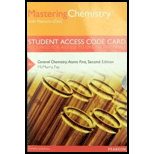
(a)
Interpretation:
The change in conductivity of n-type
Concept introduction:
Semiconductor: A material which can conduct electricity in range between a metal and an insulator is known as semiconductor. Addition of small amount of impurities increases conductivity of semiconductor and the process is known as doping. n-type and p-type are two types of doped semiconductors.
n-type: This is a type of doped semiconductor in which many free electrons are present in conduction band.
p-type: This is a type of doped semiconductor in which holes are present in valence band.
(b)
Interpretation:
The change in conductivity of p-type
Concept introduction:
Semiconductor: A material which can conducts electricity in range between a metal and an insulator is known as semiconductor. Addition of small amount of impurities increases conductivity of semiconductor and the process is known as doping. n-type and p-type are two types of doped semiconductors.
n-type: This is a type of doped semiconductor in which many free electrons are present in conduction band.
p-type: This is a type of doped semiconductor in which holes are present in valence band.
Want to see the full answer?
Check out a sample textbook solution
Chapter 21 Solutions
Masteringchemistry with Pearson Etext -- Standalone Access Code Card -- For General Chemistry
- Explain the terms : (a) Intrinsic semiconductor (b) Extrinsic semiconductor.arrow_forward(а) Give an example of zone refining of metals. (b) What is the role of cryolite in the metallurgy of aluminium?arrow_forwardSilicic acid, SiO2.xH2O(s), is a weaker acid than carbonic acid,H2CO3(aq). Write a balanced equation for the reactionof carbonic acid with a simple silicate, such as Mg2SiO4(s). Explainhow this reaction is relevant to the reduction of atmospheric carbondioxide levels over geologic time.arrow_forward
- (a) What change occurs when AgCl is doped with CdCl2?(b) What type of semiconductor is produced when silicon is doped with boron?arrow_forwardThe lead(IV) oxide used in car batteries is prepared by coat-ing the electrode plate with PbO and then oxidizing it to leaddioxide (PbO₂). Despite its name, PbO₂ has a nonstoichiometricratio of lead to oxygen of about 1/1.98. In fact, the holes in the PbO₂ crystal structure due to missing O atoms are responsiblefor the oxide’s conductivity. (a) What is the mole % of O miss-ing from the PbO₂ structure? (b) What is the molar mass of the nonstoichiometric compound?arrow_forwardSketch the band structure of a Li AND a Si crystal. (ii) How would you expect the electrical conductivity in Li AND Si crystals to vary with temperature? (iii) Account for the fact that the conductivity of Si is enhanced by the addition of small amounts of B.arrow_forward
- (a) Why electrical conductivity of the semiconductor increases with increase in temperature? Illustrate and explain the above effect with hypothetical band energy diagrams, showing one at 25 °C and another at 50 °C? (b) The number average molecular weight of polyvinyl chloride (PVC) is 110000 g/mol and the Polydispersity index (PDI) is 1.3. What is the weight average molecular weight and degree of polymerization of PVC? Note: Molar mass of vinyl chloride is 62.498 g/molarrow_forwardWhat is linkage isomerisation and why can it be important?arrow_forwardRadii were reported as follows: Ti4+ = 60 pm; O2‒ = 140 pm. Based on this, tell as much as youcan about the expected structure of TiO2 – provide the hole type for the cation, the cell lattice,and the coordination numbers for both cation and anion.arrow_forward
- Direct bandgap semiconductor materials generally support radiative (optoelectronic) transitions better compared to indirect bandgap semiconductor materials. Why?arrow_forwardDescribe the nature of electrical conduction in (a) germa- nium doped with indium and (b) cadmium sulfide doped with arsenic.arrow_forward2. Answer ALL parts a) - c). Sodium ([Ne] 3s¹3pº) forms a simple cubic (sc) primitive crystal structure, in which Na atoms are arranged at the corners of a cube. a) How many atoms are contained in the unit cell, and how many valence bands can be expected? b) Sketch the crystal orbitals at the special points ï'(0,0,0), X(1/2,1/2,0), and M(1/2,1/2,1/2), and hence draw the corresponding band structure along T-X-M-T. c) With the aid of a diagram, explain how the band structure would change if the cube was distorted into a rhombohedron by elongation along a body diagonal?arrow_forward
 Principles of Modern ChemistryChemistryISBN:9781305079113Author:David W. Oxtoby, H. Pat Gillis, Laurie J. ButlerPublisher:Cengage Learning
Principles of Modern ChemistryChemistryISBN:9781305079113Author:David W. Oxtoby, H. Pat Gillis, Laurie J. ButlerPublisher:Cengage Learning Physical ChemistryChemistryISBN:9781133958437Author:Ball, David W. (david Warren), BAER, TomasPublisher:Wadsworth Cengage Learning,
Physical ChemistryChemistryISBN:9781133958437Author:Ball, David W. (david Warren), BAER, TomasPublisher:Wadsworth Cengage Learning, Organic ChemistryChemistryISBN:9781305580350Author:William H. Brown, Brent L. Iverson, Eric Anslyn, Christopher S. FootePublisher:Cengage Learning
Organic ChemistryChemistryISBN:9781305580350Author:William H. Brown, Brent L. Iverson, Eric Anslyn, Christopher S. FootePublisher:Cengage Learning


